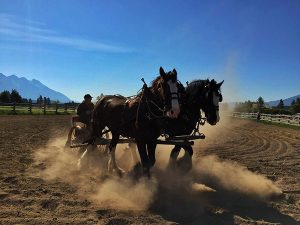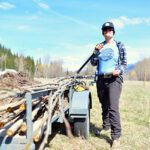Home »

Exploring Yesterday…Today
Fort Steele’s Gentle Giants
By Rylee Hunter
If you have ever been to Fort Steele Heritage Town, you would have noticed some of our most memorable citizens, our beautiful herd of Clydesdales. It is hard to ignore these gentle giants, and chances are, if you’ve ridden a wagon pulled by our Clydesdales, it would have been a highlight of your visit here.

On average, a fully grown Clydesdale weighs between 1,800 and 2,000 pounds and stands about 16 to 18 hands. The Clydesdale breed is named after its birthplace, County Clydesdale in Scotland, but has long been used on farms in North America. During Fort Steele’s boom years in the 1890s, Clydesdales would have been used for agriculture and haulage purposes.
Our Clydesdales here at Fort Steele are used for just that. You can see our Clydesdales pulling wagons full of people, or using farm equipment to plough, seed, and harvest.
Clydesdales are draught horses, meaning they have been bred over centuries for hard and heavy work. Their strength, patience, and gentle nature made them absolutely indispensable to pre-industrial age farmers.
Scottish immigrants in the Fort Steele area would have purchased Clydesdales from Scotland and used them in the nearby farms or logging yards in the Bull River area for purposes similar to what we use them for now as a heritage town. While they were a popular breed in pre-industrial times, their populations dropped drastically after the First World War and have been declared a rare heritage breed vulnerable to extinction. Fortunately, among heritage breeders such as Fort Steele, there has been a resurgent interest in Clydesdales, and their numbers have been on the rise in recent decades.
 Fort Steele’s Clydesdales were originally brought over from Oakalla Prison near Vancouver. Back in the 1950s and 1960s the prison had the inmates use the horses for farming, but when the prison closed in 1970, the Federal Government decided to sell off all the animals. As there were less than a few thousand black Clydesdales in North America in 1970 and the bloodlines and breeding at the prison were exceptionally good, there was a public outcry against dispersing the herd.
Fort Steele’s Clydesdales were originally brought over from Oakalla Prison near Vancouver. Back in the 1950s and 1960s the prison had the inmates use the horses for farming, but when the prison closed in 1970, the Federal Government decided to sell off all the animals. As there were less than a few thousand black Clydesdales in North America in 1970 and the bloodlines and breeding at the prison were exceptionally good, there was a public outcry against dispersing the herd.
It was around this time that Fort Steele was being made into a heritage site, so it was decided to transfer the Clydesdales to Fort Steele. Over 40 years later, we still have descendants of the Oakalla herd living at Fort Steele; Mary Jane and her colt, Hunter.
Fort Steele currently has a dozen Clydesdales, ranging in age from three-years-old to 20-years-old.
It is tradition that the Clydesdales born at Fort Steele to be named after historical East Kootenay residents, such as Baker, named after Colonel Baker and John (our oldest Clyde) named after Fort Steele’s founder, John Galbraith.
Come to Fort Steele this summer and experience the original meaning of horsepower! Enjoy the unique experience of riding a Clydesdale drawn wagon or watching a team of horses work at traditional farming methods.
#Clydesdales #FortSteele #ExploreYesterdayToday
– Rylee Hunter is Education Coordinator at Fort Steele Heritage Town







